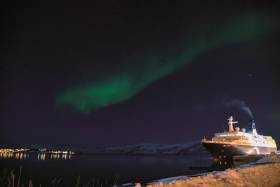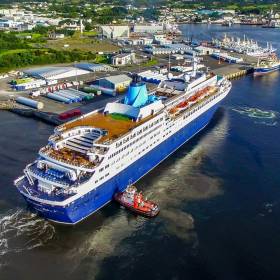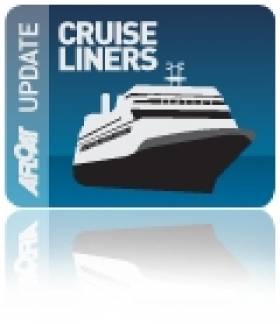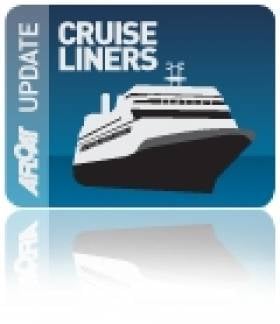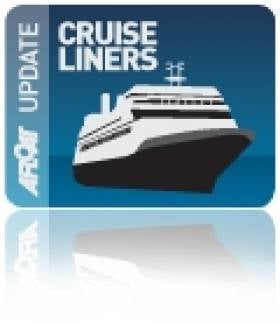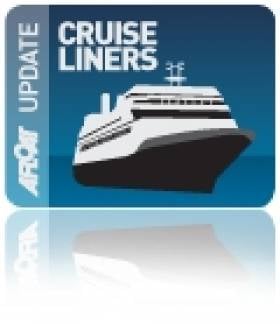Displaying items by tag: Saga Cruises
UK Operator's First Custom Built Newbuild Departs Dover On Maiden Cruise Including Dublin
Saga Cruises first ever cruiseship built for the UK operator made a maiden port of call to Dublin Port this morning as part of an inaugural round Britain and Ireland cruise, writes Jehan Ashmore.
Spirit of Discovery departed Dover last week on 10 July having made history as the first ship to use the ferryport's newly refurbished £250m cruise terminal. As part of the investment is a new number 4 berth where the new ship flagged under the Red Ensign berthed in the port's western docks.
This morning's arrival of Spirit of Discovery to Dublin Port first involved having to take a pilot on board from cutter Camac off Howth Peninsula having sailed overnight from Liverpool Cruise Terminal. The day before, the newcomer made a first call to Belfast Harbour docking at berth D1 located close to Harland & Wolff.
The 58,250 gross tonnage leadship was built by Meyer Werft at their shipyard located at the inland city of Papenburg in Germany. The newcomer with a capacity for 999 guests is built for the British market, had berthed in Dublin at Ocean Pier and will remain in port until this evening. The next cruise leg is scheduled with a passage to Cobh, Cork Harbour, thus completing in visiting the main cities on the island of Ireland.
Prior to entering service, the delivery voyage from the German shipyard required a passage upriver of the Ems River to reach the North Sea. The ship which is also to cruise in polar regions has environmental design features. Among them is a first for the shipyard with the equipment of an eSiPod propulsion system delivered by well known German firm, Siemens.
The new 236m long luxury Spirit of Discovery features the design cues of cuisine and levels of service you expect in the world’s finest boutique hotels with a private balcony for every guest. The £346m newbuild was named by the Duchess of Cornwall in a christening ceremony held in the UK on 5 July at the Port of Dover.
Two days previously the keel of a fleetmate, Spirit of Adventure was laid down at the same shipyard and is due for completion next year. With the entry then of a pair of newbuilds, Saga Cruises plan to operate a World Cruise in 2022.
The return to this ship name recalls a predecessor, the much smaller Spirit of Adventure, when operating albeit for a subsidiary brand of Saga. The small ship with just 412 passengers and at just shy of 10,000 gross tonnage had called to Irish ports.
Current operator of the ship, FTI Cruises GmbH, continues to call to Ireland but under the name Berlin which was originally given to when the cruiseship was launched in 1980. Likewise of the new 'Spirit' the older cruiseship was also built in Germany but at a different shipyard.
Whale-Watching Season Begins With St. Valentine's Cruise to 'Northern Lights' in Norway
#CruiseLiners - On this Valentine’s Day the yacht-like cruiseship Saga Pearl II is due to depart Portsmouth International Port (PIP) at 17.00 this afternoon to see the Northern Lights in Norway. It won’t just be guests on board hoping to see incredible sights.
According to PIP, a team from ORCA, a marine conservation charity based in the UK's second busiest ferryport, will also be joining the crew of the Saga Cruises ship on the 15 night holiday. It will be the first survey of 2018 for ORCA, one of eleven journeys they will be making from Portsmouth with Saga this year to learn more about marine mammals and habitats in which they live.
The cruise from the historic maritime city of Portsmouth explores Norway's coastal waters and heads into the Arctic Circle. Last year's cruises to the same area saw everything from humpback whales to harbour porpoises, and sperm whales to pilot whales.
ORCA has also just announced it is to partner with another cruise ship operator at Portsmouth. Noble Caledonia specialises in small cruise ship holidays accessing incredible natural habitats that larger vessels can’t visit. A “unique and innovative marriage” between the charity and Noble Caledonia is expected to expand a citizen’s science programme onboard the small luxury liners.
Tim Cochrane, Noble Caledonia Managing Director, said “I am delighted to be able to introduce this concept into our expedition tours and to be working with ORCA: I know that our guests will relish being part of this exciting initiative as part of their holiday with us such that they can take away even more than the lasting memories our holidays provide. The opportunity to join in with some of the scientific research being undertaken by our knowledgeable and experienced expedition team members, many of whom are experts in their own fields, will, I am sure, enhance guest experience on our expedition tours”.
Saga Pearl II is the smallest of the operator's fleet and as Afloat reported the intimate 449 passenger cruiseship has in recent years called to Warrenpoint, where there are plans to boost cruise tourism.
Public Take 'Saga-Selfies' As Cruiseship Makes Return Call to Warrenpoint
#cruiseliners - Warrenpoint Harbour welcomed the return call of a cruiseship to the Co. Down port that first launched this trade in recent years, writes Jehan Ashmore.
Saga Pearl II had arrived into the scenic surroundings of Carlingford Lough last week having among its all-Ireland ports of call included Cobh, Cork Harbour.
The southern port this year had its first cruiseship, Saga Pearl II as Afloat previously reported.. The photo supplied for that coverage was actually that of her namesake predecessor, Saga Pearl which currently operates for other another company.
At just 18,000 gross tonnes, Saga Pearl II has the advantage of getting to visit smaller and lesser well known ports in Ireland and the UK as part of cruise itinerary also launched in recent years. This allows Saga cruisegoers to reach destinations that most giant cruiseships cannot.
On this rare occasion of a cruiseship call, Warrenpoint Harbour Authority organised a special public opening of the port through the Town Dock Office. This was to enable the public to gain access to view Saga Pearl II. Previously the cruiseship's historic first port visit in 2014 also drew in the crowds.
The public on this latest call were encouraged to get a 'Saga-Selfie' with the background of the cruiseship described by owners as a small yacht-like ship. With no more than 449 passengers on board and reserved exclusively as an adults-only ship.
There are seven passenger decks. Across these decks are facilities that include a small cinema, gymnasium, spa, hair and beauty salon, library, shop, card room and a
launderette.
Dublin Port Cruise Calls To Increase in 2017 While Dun Laoghaire Remains With Last Year's Total
#CruiseIncrease – Dublin Port in 2017 is to welcome a total of 125 cruise calls an increase on last year, however Dun Laoghaire Harbour will have a repeat of last year with eight calls, writes Jehan Ashmore.
As previously reported on Afloat, Fred Olsen’s Boudicca became the first caller of the New Year and follows last year's total of 112 calls. Of these calls for season 2017 the most regular caller scheduled will be Princess Cruises 3,142 passenger 'Grand' class giant, Caribbean Princess.
The 112,894 gross tonnage ship hit the headlines for all the wrong reasons last year due to a power-failure and use of a 'magic polluting pipe'.
At Dun Laoghaire Harbour is where a handful of calls totalling eight cruiseships called in 2016. This is to be repeated with another welcome this year to the south Dublin Bay harbour. On previous seasons the total has been around a dozen calls.
The majority of callers been from operator Windstar Cruises. Once again their impressive five-mast sail assisted Wind Surf, the most frequent caller since the trade to the harbour was revived in 2011 is to make two visits in 2017. In addition to fleetmates but of conventional tonnage.
Afloat has examined the cruiseship list season 2017 and notably there will be no giant cruiseships making anchorage calls off Dun Laoghaire Harbour. This is due to smaller sized cruiseships and therefore they will be accommodated within the harbour alongside Carlisle Pier.
This year Dun Laoghaire Harbour can look forward to celebrating a significant milestone as it is the 200th anniversary of the beginning of its construction in 1817. This was to provide a port of 'refuge' with a single pier as originally planned. This pier ultimately became the East Pier, following the completion of this feat of marine engineering in 1842 with the building of the West Pier to form the ‘asylum’ harbour.
Saga's Northern Adventure from Donegal to Down
#CruiseNorth – Saga Cruises, part of the wider Saga brand that caters for UK consumers over 50, has been calling to ports in counties, Donegal and Down, contributing to boosting tourism in these northern regions, writes Jehan Ashmore.
The caller on the Wild Atlantic Way seaboard at Killybegs, was that of Saga Sapphire, one of the most elegant looking cruiseships docked on Wednesday. The 752 capacity cruiseship was assisted into Killybegs by Sinbad Marine’s tug, SMS Cian. Cruisegoers visited attractions among them Glenveagh National Park.
On the Irish Sea, Saga Cruises visit to Warrenpoint, is where the more intimate fleetmate, Saga Pearl II with just 449 passengers, visited last month according to Point Shipping Services.
The cruises are part of Hidden Britain itinerary, to visit never before ports of call, outside that of the mainstream cruise destinations that invariably are larger ports located in towns and cities.
Saga Pearl II returned to Carlingford Lough as the sole caller this season, having made a historic Warrenpoint call as the first ever cruiseship to dock at the port at the foot of the Mourne Mountains in 2014. The scenic coastal area is been promoted as a destination by Warrenpoint Harbour Authority and CruiseWarrenpoint.
Saga Sapphire represented the 10th caller out so far to dock in Killybegs out of the season’s total of 12 callers scheduled. The fishing and energy sector port has seen the cruise sector expand in recent years thanks to the Killybegs Information Centre, a development of Donegal Tourism.
Next to call is Holland America Lines smallest cruiseship, Prisendam with a 835 capacity on 1st September. Ending the season is left to Fred. Olsen Cruise Lines graceful, Boudicca and with a similar passenger total of 880 and which is to call a week later.
#CruiseCarlingford- Furthermore to our previous report on Warrenpoint Port, the harbour welcomed the first visit of a cruise ship, the Saga Pearl 2 last month to the harbour on the shores of Carlingford Lough.
According to the Belfast Telegraph, the (Saga Cruises) ship was making a Britain and Ireland Explorer cruise with 800 people on board, who disembarked in the local town and visited the region.
CEO of Warrenpoint Harbour Commissioners Peter Conway said, "We are hoping that this is the start of new business for us and that we can help welcome more tourists to this beautiful part of Co Down. There are also plans for a 200-berth yachting marina and we are trying to secure funding."
Mr Conway added: "We would be prepared to invest £2m in this £5m project; there is an inherent demand for leisure activity on Carlingford Lough."
It's understood the port has also been in negotiations with a view to a possible purchase of the port at Greenore in the Republic, the only privately-owned port in Ireland.
The port is most famous for being used to fit out the ships used for the pirate radio station Radio Caroline which Afloat.ie reported about the 50th anniversary since first broadcasting across the Irish Sea off Ramsey, Isle of Man in 1964.
Mr Conway said he had ambitions to broaden the port's appeal. "Warrenpoint is primarily a commercial port, but we have other stakeholders and we think that it is important that we put something back into the local community which is why we want to develop the cruise business and marina, and open up this part of Northern Ireland to a wider audience".
Warrenpoint also accommodates a small but successful mussel-dredging fleet, selling to customers in the Netherlands and Belgium. Local fishermen also sell scallop and crab to some of the top Northern Ireland restaurants.
The board in December 2013 also agreed to the construction of a new £3m grain storage facility and conveyor system.
In October this year the Warrenpoint Harbour Authority will host the 2014 British Ports Association (BPA) 2014 annual conference.
The event, to be based at the Slieve Donard Resort in Newcastle, is expected to attract around 200 delegates.
Cruiseship Call to Cobh on Irish Debut
#CRUISE LINERS – The newest addition to the Saga Cruises fleet Saga Sapphire (1981/37,301gt) is to make her debut to Dublin Port tomorrow, having made her inaugural Irish port of call to Cobh today, writes Jehan Ashmore.
Saga Sapphire previously the Bleu de France and launched as Europa for Hapag Lloyd, underwent a major refit taking several months in the Sicilian port of Palermo at the Fincantieri shipyard.
She arrived into her homeport of Southampton in preparation for her new owners 'maiden' cruise in late March which was delayed by several days. The delay in redelivering the 706-passenger cruiseship was due to strike action over redundancies at the shipyard.
Tomorrow she is due to berth in the capital port at Ocean Pier under the command of Captain Philip Rentell who has worked with the UK based operator when he joined the company in 2005 as master on their Saga Rose.
Quest for Adventure finds the Foyle
#CRUISE CALLS – The opening cruiseship caller for this year in Londonderry was marked by the arrival this morning of the 446 passenger Quest for Adventure, writes Jehan Ashmore.
She docked at Lisahally, downriver of the north-west city, having sailed overnight from Dublin Port. The 18,000 tonnes vessel is also operating on her first season for UK based Saga Cruises.
A further seven cruise calls are scheduled this season, noting each visit will be taken by individual ships as there will be no repeat calls. Since 1995 the Foyle have welcomed these vessels.
Asides Lisahally, they can also berth at the city-quays or at anchorage off Greencastle, Co. Donegal.
Cruiseship Boost for Belfast
#CRUISE LINERS-Belfast Harbour looks forward to another bumper year as cruise operators are to increase by 32% compared to last year, with 41 cruise ships bringing almost 75,000 visitors to the port.
The following major operators are to visit: Cruise & Maritime Voyages, Fred Olsen Cruise Lines, Holland America Line, Princess Cruises and Saga Cruise and others will dock from far flung destinations.
At over 1km long, Stormont Wharf, will again be the main berth for cruiseships in particular the ability to accommodate an increasing trend in larger class vessels touring the Irish Sea. The wharf was extended in recent years at a cost of £10m and is the longest deepwater quay in Ireland.
To promote Belfast Harbour as a cruiseship destination, the port and the Belfast Visitor and Convention Bureau (BVCB) set up the Cruise Belfast Initiative to market the location internationally.
For further information visit www.cruise-belfast.co.uk and to view the seasons schedule of cruise callers click HERE.
Cruise Liners Line-Up for Foyle
#CRUISE LINERS-Aside the main ports where most cruise ships visit while touring this island, Londonderry would be a less frequent destination, as such vessels only began visiting the north-west port since 1995, writes Jehan Ashmore.
Some of the leading operators though have called over the years called to the port, they are: Crystal Cruises, Cunard Line, Residensea, Seabourn and Silverseas.
This year's line-up will see eight scheduled calls starting in May with the 446 passenger Quest for Adventure (for more click HERE) built in 1981 and operated by Saga Cruises. A younger near-sister Astor built in 1987 is also due to call in August.
Below is a list of the cruise callers and dates.
Quest for Adventure 9 May
Marco Polo 14 July
Prinsendam 16 July
Astor 11 August
Clipper Odyssey 18 August
Princess Daphne 30 August
Albatross 12 September
Ocean Countess 15 September
The vessels will use various berths dependent upon size within the port which is run by the Londonderry Port and Harbour Commissioners. The facilities are at the city quays, Lisahally or require anchorage off Greencastle in Lough Foyle.



























